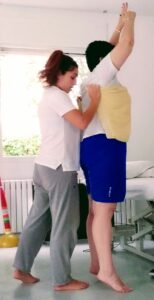Many of the neurological patients, whether due to cerebellar ataxia, stroke, Parkinson’s disease or other, have impaired balance and postural control. The rehabilitation and treatment of these disorders and alterations is essential for the patient to regain control of his movement and independence and functional autonomy. In some cases, we not only talk about recovery, but also in maintenance, since within neurological diseases we also include neurodegenerative diseases, with which the objective is not always to recover but also to prevent the deterioration and progression of the motor sequelae of the disease.
In therapy sessions aimed at recovery of balance, the factors that provide stability and body orientation should be influenced. That is why we incorporate therapeutic exercises in physiotherapy sessions that promote the correction of the alignment of the different parts of the body and these in space.
It is important to select the correct exercises that encourage the patient to maintain the position of the body within stability limits and always thinking about the patient’s motor needs. In other words, find out which muscle groups should be strengthened (e.g., enhance back extensors in a patient with multiple sclerosis presenting a predominance of the flexor posture), which motor strategies should be encouraged and design an appropriate task (eg, extension of everything the body). Once each sensitive, motor and perceptive component of the task has been worked on (eg trunk extension, arm extension, ability to keep the body in an upright position etc.), a motivating activity for the treatment session must be incorporated into the treatment session. patient at the end of the session (ex .: organize a high shelf).
